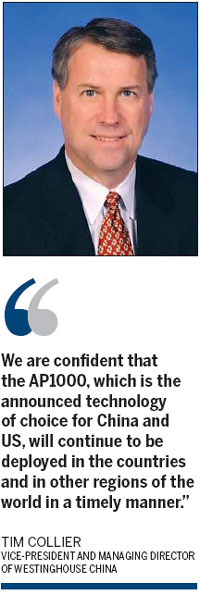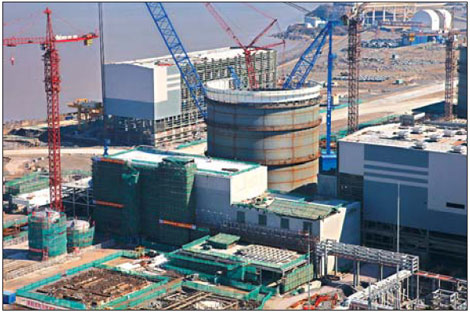Company Special: Westinghouse talks benefits of nuclear energy
|
The first unit at Sanmen nuclear power project will start generating electricity in 2013. China is using Westinghouse's AP1000 technology to build four reactors in the country. Photos Provided to China Daily |
Editor's note: As a global pioneering nuclear energy company, the US-based Westinghouse Electric Company has been following the rich history in the nation and playing an active role in the domestic nuclear energy sector since the 1990s. The country is using Westinghouse technology to build four AP1000 pressurized water reactor (PWR) units, two in Sanmen, Zhejiang province and two in Haiyang, Shandong province. The four units are the first Generation III+ nuclear power plant projects in the world and part of a national plan to utilize more clean and secure energy to power its economy.
For the global nuclear industry, 2011 had been an eventful year. How would Westinghouse review its business last year? What are the company prospects for the domestic market? China Daily interviewed Tim Collier, vice-president and managing director of Westinghouse China.
Q: Compared with other energy sources, such as wind and solar, what are the advantages of nuclear energy?
A: Our world is growing, and it is our responsibility to improve the standard of living for the generations that follow us. The way we respond to energy demands must support this growth and improved living conditions. By 2020, there will be an additional two billion people placing higher demands on electricity, and fossil fuels alone cannot satisfy this demand. Additionally, our quality of life and energy security demands changes in the way fossil fuels are used. Renewable energy sources, such as solar and wind are still in their infancy and, when used alone, are not realistic solutions to meet increasing demand because of their intermittent supply of electricity.
Nuclear power is a proven, safe, secure, plentiful and clean source of power generation. Nuclear energy can provide reliable power day and night without releasing carbon dioxide. The United States relies on nuclear energy for 20 percent of electricity and nearly 70 percent of carbon-free electricity production. China's leadership has recognized the benefit of additional nuclear powered electricity as part of a stable and sustainable electricity supply and therefore the China nuclear industry has seen rapid growth in the recent years. This has provided great opportunities to Westinghouse. We are honored and excited to be in China and to be part of this historic moment.
Q: What is a unique advantage of your AP1000 technology?

A: Our AP1000 PWR is the only Generation III+ reactor to receive Design Certification from the US Nuclear Regulatory Commission (NRC). It is also extremely important following the events of March 11, 2011 to note that the AP1000 technology uses passive features to ensure plant safety.
The AP1000 technology, based on the proven performance of Westinghouse-designed PWRs, is an advanced nuclear power plant that uses the forces of nature and simplicity of design to enhance plant safety and operations and reduce construction costs. Its passively safe reactor design uses natural cooling, evaporation and condensation for greater safety. This design makes for a smaller, simpler, easier-to-build plant.
Designed to be more than 200 times safer than United States Nuclear Regulatory Commission requirements, the AP1000 plant is able to withstand the most extreme events making it the leading technology of choice around the world. In the 90-day report following Fukushima, the US NRC noted that the AP1000 design already contains many of the plant improvements that were being recommended for other plant designs. These points were key factors in the recent US NRC certification of the current design.
Q: China is building the most nuclear power plants in the world nowadays. What are your prospects for the market? How are the most recent developments of the Sanmen and Haiyang projects going?
A: China's State Nuclear Power Technology Corporation Ltd (SNPTC) in 2007 signed the historical agreement with Westinghouse and its consortium partner the Shaw Group to design and build four AP1000 nuclear power units at Sanmen and Haiyang. For Westinghouse, nothing is more important than the successful accomplishment of the four units at present.
The plants are all under construction and will come online beginning in 2013.
We understand the China government decision for continued growth of nuclear power and Westinghouse will do our part to support this decision. There is no doubt that China represents a strategically important market for Westinghouse. Besides our nuclear power plants business, our three other business, nuclear fuel, nuclear services and nuclear automation, are all taking a close look of the market for future growth opportunities.
Q: What have you accomplished on technology transfers to Chinese customers?
A: Westinghouse has a track record of technology transfers and localization that is unsurpassed around the world as evidenced by the long-term relationships we have built in places like France, Japan, Korea and other countries that have embraced nuclear energy.
We are achieving the same results in China with all-round technology transfers.
Almost all of the supporting documentation has been provided and more than half of the training has been conducted. The technology transfers are going very smoothly. It supports Chinese self-reliance in engineering, manufacturing and services for future AP1000 plants in China.
Q: What are the developments of AP1000 projects in the US?
A: In the United States, the AP1000 design has been selected for more than half of the new plants announced, including the only six for which engineering, procurement and construction contracts have been signed.
In December 2011, the NRC granted Westinghouse the Design Certification Amendment to revision 19 of the design. The granting of such certification is the foundation upon which utilities will construct and operate AP1000 units in the United States.
On Feb 9, the US NRC approved the license for Southern Nuclear to build and operate two AP1000 units at the Vogtle site in Georgia.
These will be the first Generation III+ units ever built in the United States, and the first new plants of any type approved for construction in the country in three decades.
Q: How do you see the impact of the Japan nuclear incident on the global nuclear industry?
A: The problems at Japan's Fukushima Daiichi nuclear energy facility after the devastating earthquake and tsunami in March prompted concerns about the future of nuclear energy. As a result, public scrutiny and regulatory oversight of our industry, which have always been high, have become even more intense.
We understand and welcome this additional interest and oversight and are responding to the challenges to become even more transparent and accessible to regulatory agencies, government officials and the public.
As a learning industry, we are aggressively studying the events that occurred in Japan. The robust and passive features of the AP1000 include many of the recommendations that are currently being planned for other designs. As more lessons are learned, we expect to build on the existing design features to make the design even safer.
The United States and other nations have reaffirmed their intent to move forward with the development of new nuclear energy facilities. Using passive generation III reactor designs will add an extra margin of safety. We are confident that the AP1000, which is the announced technology of choice for China and US, will continue to be deployed in the countries and in other regions of the world in a timely manner.
(China Daily 02/15/2012 page15)















